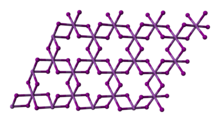
| |

| |
| Names | |
|---|---|
| IUPAC name
Scandium(III) chloride
| |
| Other names
scandium chloride
scandium trichloride | |
| Identifiers | |
3D model (JSmol)
|
|
| ChemSpider | |
| ECHA InfoCard | 100.030.714 |
PubChem CID
|
|
| RTECS number |
|
| UNII | |
CompTox Dashboard (EPA)
|
|
| |
| |
| Properties | |
| ScCl3 | |
| Molar mass | 151.31 g/mol |
| Appearance | grayish-white crystals |
| Density | 2.39 g/mL, solid |
| Melting point | 960 °C (1,760 °F; 1,230 K)[1] 63 °C (hexahydrate) |
| 70.2 g/100 mL | |
| Solubility in other solvents | soluble in alcohol, acetone, glycerin insoluble in EtOH[citation needed] |
| Hazards | |
| Occupational safety and health (OHS/OSH): | |
Main hazards
|
irritant |
| NFPA 704 (fire diamond) | |
| Lethal dose or concentration (LD, LC): | |
LD50 (median dose)
|
3980 mg/kg (mouse, oral) |
| Safety data sheet (SDS) | External MSDS |
| Related compounds | |
Other anions
|
Scandium(III) fluoride Scandium bromide Scandium triiodide |
Other cations
|
Yttrium(III) chloride Lutetium(III) chloride |
Related compounds
|
Scandium(III) nitrate |
Except where otherwise noted, data are given for materials in their standard state (at 25 °C [77 °F], 100 kPa).
| |
Scandium(III) chloride is the inorganic compound with the formula ScCl3. It is a white, high-melting ionic compound, which is deliquescent and highly water-soluble.[2] This salt is mainly of interest in the research laboratory. Both the anhydrous form and hexahydrate (ScCl3•6H2O) are commercially available.
- ^ Frederikse, H.P.R.; Lide, David R. (1998). CRC Handbook of Chemistry and Physics (78th Edition)
- ^ Greenwood, Norman N.; Earnshaw, Alan (1997). Chemistry of the Elements (2nd ed.). Butterworth-Heinemann. ISBN 978-0-08-037941-8.
